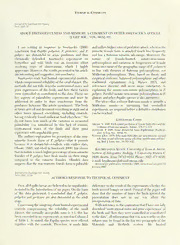
About distastefulness and mimicry: A comment on Peter Smetacek's article (J. Lep. Soc., Vol. 60 : 82-85) PDF
Preview About distastefulness and mimicry: A comment on Peter Smetacek's article (J. Lep. Soc., Vol. 60 : 82-85)
Technical Comments JournaloftheLepidopterists'Society 61(1).2007,57 ABOUT DISTASTEFULNESS AND MIMICRY: A COMMENT ON PETER SMETACEK'S ARTICLE LER SOC, VOL. 60:82-85) (J. I am writing in response to Smetaceks (2006) andsuffers higherratesofpredatoryattack,whereasthe conclusion that Papilio polyctor, P. protenor, and P. mimetic female form is attacked much less frequently polijtes are distasteful to avian predators and thus and has a Batesian mimetic advantage. Moreover, the chemically defended. Smetaceks experiment on nature of female-limited mimic—non-mimic butterflies and wild birds was an immense effort polymorphism and variation in frequencies of female involving years of observations, which I highly forms over most ofthe geographic range ofP. polijtes is appreciate. However, the resultspresentedinhis article in line with theories of Batesian polymorphism, not are interestingand suggestive, not conclusive. Miillerian polymorphism. Thus, based on theory and Smetaceks study had limited experimental controls, empirical evidence, balanced polymorphism and other which compromised reliabilityofthe small dataset. The traditional explanations (e.g. Turner 1978, and methods did not fully describe motivational states and references therein) still seem more satisfactory in prior experiences of the birds, and how these factors explaining the mimic-non-mimic polymorphism in P were controlled or contributed to the data. These are polijtes. Parallel mimic-non-mimic polymorphism in P. key aspects of palatabilitv experiments and must be glaucus and—otherPapilio species is also instructive. addressed in order to draw conclusions from die The idea that a—classic Batesian mimic is actuallva predators' behavior. The article mentioned, "The birds Miillerian mimic is intriguing but controlled attimes arrivedanddevouredeverythingin sight andat experiments are required before a definitive conclusion other times ignored everything, including; controls, can be reached. having evidently found sufficient food elsewhere." We do not know how much of the variation in measured Literature Cited palatability was introduced by this lack of control, Ohsaki, N. 1995. Preferentialpredationoffemalebutterfliesanddie evolutionofbatesianmimicry. Nature,378:i73-175. motivational states of the birds and their prior Smetacek, P. 2006. Some distasteful Asian Papilioninae (Papilion- experiencewith unpalatable prey. idae). Lep.Soc.,60:82-85. The author's explanation for persistence ofthe non- TUKNER,J.JR..G. 1978.Whymalebutterfliesarenon-mimetic:natural — selection,sexualselection,groupselection,modificationandsiev- mimetic female form o—f P. polijtes that it persists ing. Biol.J.Linn.Soc, 10:385-432. because it is distasteful conflicts with earlier data. Ohsaki (1995, not cited in Smetacek 2006) has shown Krushnamegh Kunte, UniversityofTexasatAustin. thatinnatureamuchhigherpercentage ofnon-mimetic Section ofIntegrative Biology, 1 University Station C females ofP. polijtes have beak marks on their wings 0930, Austin, Texas 78712-0253. Phone: (512)471-8240, compared to the mimetic females. Ohsaki's data e-mail: [email protected] suggests that the non-mimetic female form is palatable Receivedforpublication 10October2006,revisedandaccepted15 January2007 JournaloftheLepidopterists'Society 61(1),2007,57-58 AUTHOR'S RESPONSE TO TECHNICALCOMMENT First, allPapiliolarvaearebelievedtobeunpalatable, difference to the result ofthe experimentswhetherdie as stated in the Introduction ofmypaper. On the basis birds arrived hungryor sated. Perusal ofdie paperwill of the data presented, I concluded that P polijtes, show that the number of times the birds ignored the polyctor and protenor are also distasteful in the adult presentation does not in any way affect die stage. interpretation ofdata. Concerningthe misgivingaboutlimitedexperimental With reference to the contention that I have notfullv controls compromising the reliability of the small described"motivationalstates andpriorexperiences"of dataset, the normally acceptable ratio is 1:1; this has the birds and "howdieywere controlled orcontributed beenexceededinmyexperiments as notedin Column2 to the data", allinformation thatwasnoteworthyonthis ofTable 1. As stated, the Papilio species were offered subject may be found in the last two paragraphs ofthe together with the controls. Therefore, it made little Materials and Methods section. My limited
